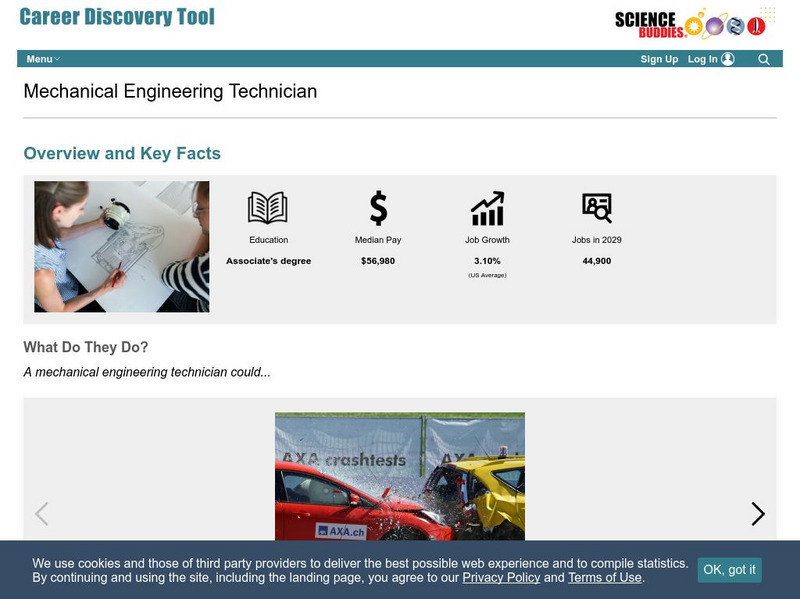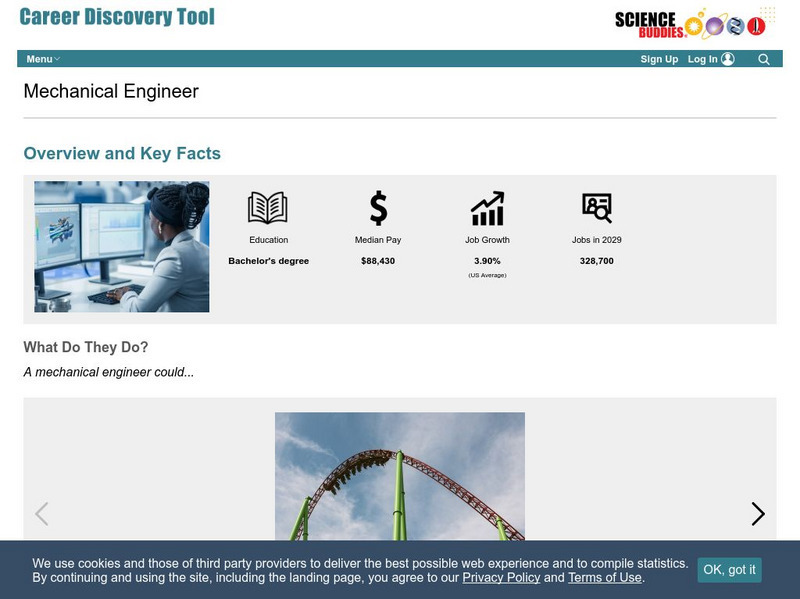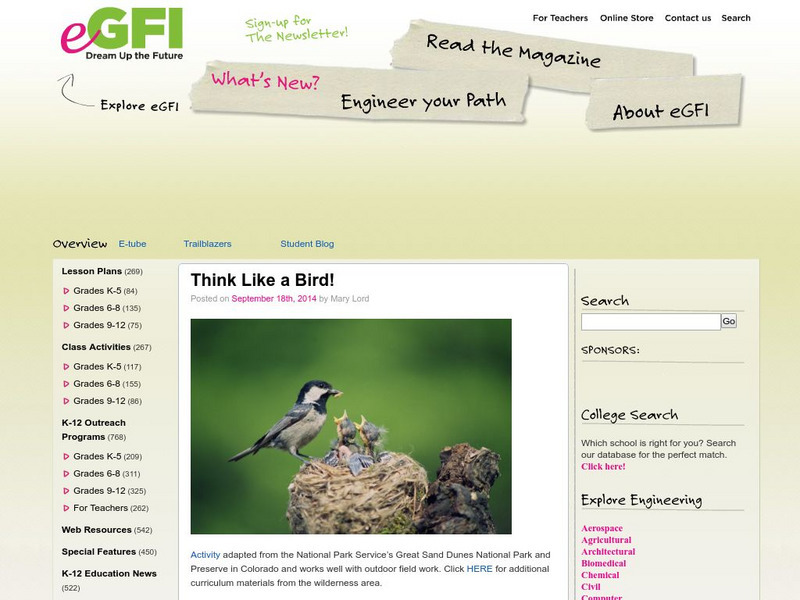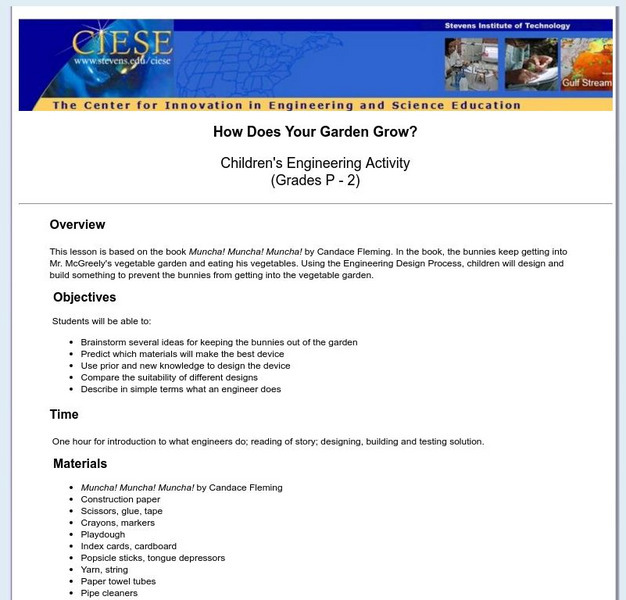Hi, what do you want to do?
Science Buddies
Science Buddies: Career Profile: Computer Software Engineer
For those students interested in developing cool video game software for computer or those who enjoy applying their compter science skills to solve problems, a career as a computer software engineer might be worth examining. This Science...
Science Buddies
Science Buddies: Science Careers: Mechanical Engineering Technician
The mechanical engineering technician supports the mechanical engineer in designing all sorts of things we use in our everyday lives. This Science Buddies site lays out the requirements needed to become a mechanical engineering...
Science Buddies
Science Buddies: Science Careers: Mechanical Engineer
All kinds of apparatus used in every day life are designed by the mechanical engineer. The career casts a broad engineering net. This Science Buddies site lays out the requirements needed to become a mechanical engineer, as well as the...
Other
Fuel Our Future Now: Gr. 6 8 Module: Designing a Vehicle for the Year 2020 [Pdf]
In this 6-8 teaching module, learners learn about natural resources, human impact on the environment, and engineering design in vehicle transportation. Using real world scientific data and scientific reasoning skills, they investigate...
PBS
Pbs Learning Media: Aerospace Engineering
This collection of Aerospace Engineering learning modules will allow students to explore video and interactive media resources that support the middle and high school Engineering Design core ideas.
Science Buddies
Science Buddies: Bridge Building Bonanza: Which Design Wins?
In this activity, you build and test two types of bridges: a simple suspension bridge and a beam bridge. Which bridge design is stronger?
TryEngineering
Try Engineering: Eeeek a Mouse!
Young scholars investigate how a mouse works by dissembling and evaluating its design. They are also challenged to improve the design by eliminating or changing components of the mouse they dissembled.
Discovery Education
Discovery Education:nanotechnology,biological Engineering and Biosensors [Pdf]
A lesson plan where students use their innovative thinking skills to design biosensors for a future use. During the instructional activity, students will learn about nanotechnology and biosensors.
Other
American Society for Engineering Education: E Gfi: Activity: Keep a Cube
In this activity, student teams in grades K-6 explore the design process by engineering a way to keep an ice cube from melting for 30 minutes. [6:00]
Other
American Society for Engineering Education: E Gfi: Think Like a Bird!
Students learn about wildlife habitats, environmental engineering, and the complexities of nest construction by attempting to design and build a nest themselves. This activity can be done individually or with a partner.
TryEngineering
Try Engineering: A Question of Balance
Students work in teams to fill jars with a product that is uniform in weight or count. Lesson investigates how manufacturing engineers use weight scales and measurement to develop systems that can create consistent products.
TeachEngineering
Teach Engineering: Concentrated Solar Power
Young scholars learn how the total solar irradiance hitting a photovoltaic (PV) panel can be increased through the use of a concentrating device, such as a reflector or lens. This is the final lesson in the Photovoltaic Efficiency unit...
TeachEngineering
Teach Engineering: Learn to Build a Rocket in 5 Days or Your Money Back
In this lesson, students discover the entire process that goes into designing a rocket for any customer. In prior lessons, students learned how rockets work, but now they learn what real-world decisions engineers have to make when...
Center for Innovation in Engineering and Science Education, Stevens Institute of Technology
Ciese: How Does Your Garden Grow?
Based on the book Muncha! Muncha! Muncha! by Candace Fleming. Students must use the engineering design process to plan and build a barrier that will keep hungry bunnies out of a garden.
Center for Innovation in Engineering and Science Education, Stevens Institute of Technology
Ciese: Scratch My Back
Starting with the book Big Smelly Bear by Britta Teckentrup, young scholars use the engineering design process to design a solution to the bear's problem of not being able to scratch an itchy back.
Center for Innovation in Engineering and Science Education, Stevens Institute of Technology
Ciese: The Three Little Pigs
Learners are asked to use the engineering design process to construct a house for the third pig in The Three Little Pigs story that can withstand the huffing and puffing of the wolf.








![Fuel Our Future Now: Gr. 6 8 Module: Designing a Vehicle for the Year 2020 [Pdf] Lesson Plan Fuel Our Future Now: Gr. 6 8 Module: Designing a Vehicle for the Year 2020 [Pdf] Lesson Plan](https://static.lp.lexp.cloud/images/attachment_defaults/resource/large/FPO-knovation.png)






